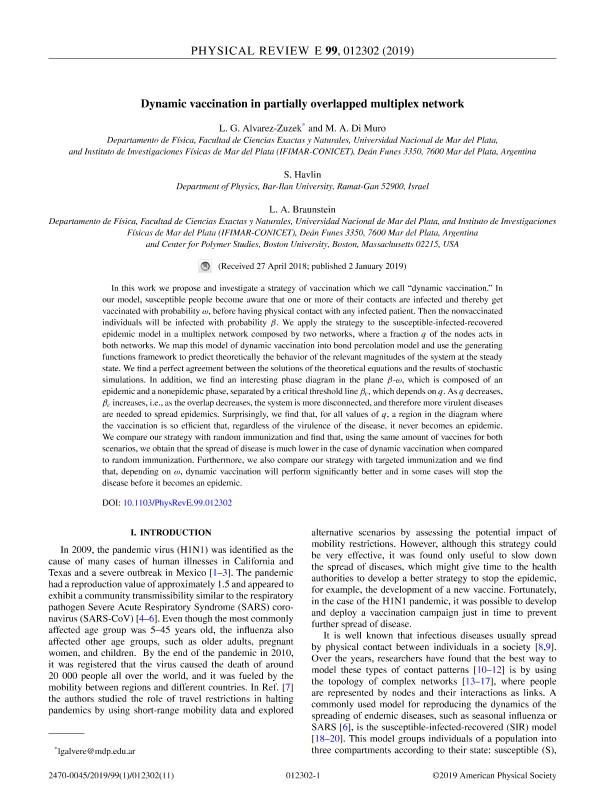Mostrar el registro sencillo del ítem
dc.contributor.author
Alvarez Zuzek, Lucila Gisele

dc.contributor.author
Di Muro, Matias Alberto

dc.contributor.author
Havlin, S.
dc.contributor.author
Braunstein, Lidia Adriana

dc.date.available
2020-12-11T16:02:56Z
dc.date.issued
2019-01
dc.identifier.citation
Alvarez Zuzek, Lucila Gisele; Di Muro, Matias Alberto; Havlin, S.; Braunstein, Lidia Adriana; Dynamic vaccination in partially overlapped multiplex network; American Physical Society; Physical Review E; 99; 1; 1-2019
dc.identifier.issn
2470-0045
dc.identifier.uri
http://hdl.handle.net/11336/120229
dc.description.abstract
In this work we propose and investigate a strategy of vaccination which we call "dynamic vaccination." In our model, susceptible people become aware that one or more of their contacts are infected and thereby get vaccinated with probability ω, before having physical contact with any infected patient. Then the nonvaccinated individuals will be infected with probability β. We apply the strategy to the susceptible-infected-recovered epidemic model in a multiplex network composed by two networks, where a fraction q of the nodes acts in both networks. We map this model of dynamic vaccination into bond percolation model and use the generating functions framework to predict theoretically the behavior of the relevant magnitudes of the system at the steady state. We find a perfect agreement between the solutions of the theoretical equations and the results of stochastic simulations. In addition, we find an interesting phase diagram in the plane β-ω, which is composed of an epidemic and a nonepidemic phase, separated by a critical threshold line βc, which depends on q. As q decreases, βc increases, i.e., as the overlap decreases, the system is more disconnected, and therefore more virulent diseases are needed to spread epidemics. Surprisingly, we find that, for all values of q, a region in the diagram where the vaccination is so efficient that, regardless of the virulence of the disease, it never becomes an epidemic. We compare our strategy with random immunization and find that, using the same amount of vaccines for both scenarios, we obtain that the spread of disease is much lower in the case of dynamic vaccination when compared to random immunization. Furthermore, we also compare our strategy with targeted immunization and we find that, depending on ω, dynamic vaccination will perform significantly better and in some cases will stop the disease before it becomes an epidemic.
dc.format
application/pdf
dc.language.iso
eng
dc.publisher
American Physical Society

dc.rights
info:eu-repo/semantics/openAccess
dc.rights.uri
https://creativecommons.org/licenses/by-nc-sa/2.5/ar/
dc.subject
SPREADING DISEASES MODEL
dc.subject
MULTIPLEX NETWORKS
dc.subject
BOND PERCOLATION
dc.subject
GENERATING FUNCTION FRAMEWORK
dc.subject.classification
Otras Ciencias Físicas

dc.subject.classification
Ciencias Físicas

dc.subject.classification
CIENCIAS NATURALES Y EXACTAS

dc.title
Dynamic vaccination in partially overlapped multiplex network
dc.type
info:eu-repo/semantics/article
dc.type
info:ar-repo/semantics/artículo
dc.type
info:eu-repo/semantics/publishedVersion
dc.date.updated
2020-11-30T14:17:51Z
dc.journal.volume
99
dc.journal.number
1
dc.journal.pais
Estados Unidos

dc.description.fil
Fil: Alvarez Zuzek, Lucila Gisele. Universidad Nacional de Mar del Plata; Argentina. Consejo Nacional de Investigaciones Científicas y Técnicas. Centro Científico Tecnológico Conicet - Mar del Plata. Instituto de Investigaciones Físicas de Mar del Plata. Grupo de Investigación del Departamento de Química de la Unmdp | Universidad Nacional de Mar del Plata. Facultad de Ciencias Exactas y Naturales. Instituto de Investigaciones Físicas de Mar del Plata. Grupo de Investigación del Departamento de Química de la Unmdp; Argentina
dc.description.fil
Fil: Di Muro, Matias Alberto. Universidad Nacional de Mar del Plata; Argentina. Consejo Nacional de Investigaciones Científicas y Técnicas. Centro Científico Tecnológico Conicet - Mar del Plata. Instituto de Investigaciones Físicas de Mar del Plata. Grupo de Investigación del Departamento de Química de la Unmdp | Universidad Nacional de Mar del Plata. Facultad de Ciencias Exactas y Naturales. Instituto de Investigaciones Físicas de Mar del Plata. Grupo de Investigación del Departamento de Química de la Unmdp; Argentina
dc.description.fil
Fil: Havlin, S.. Bar-ilan University; Israel
dc.description.fil
Fil: Braunstein, Lidia Adriana. Boston University; Estados Unidos
dc.journal.title
Physical Review E
dc.relation.alternativeid
info:eu-repo/semantics/altIdentifier/url/https://journals.aps.org/pre/abstract/10.1103/PhysRevE.99.012302
dc.relation.alternativeid
info:eu-repo/semantics/altIdentifier/doi/http://dx.doi.org/10.1103/PhysRevE.99.012302
Archivos asociados
